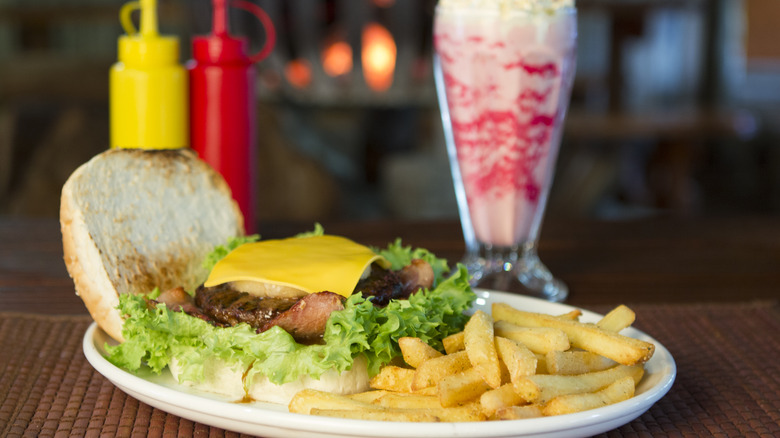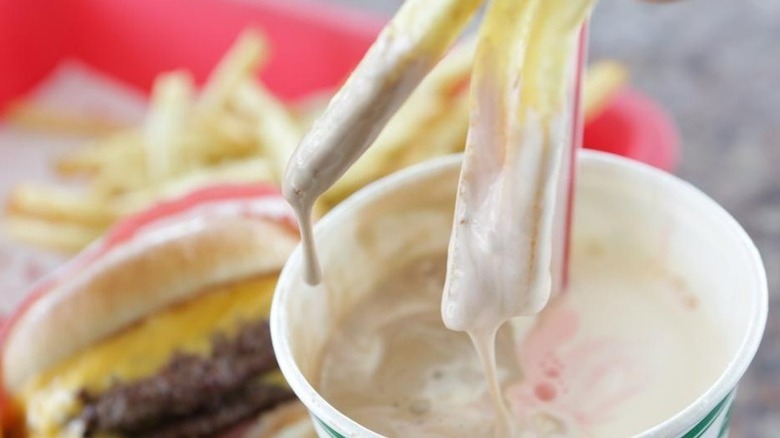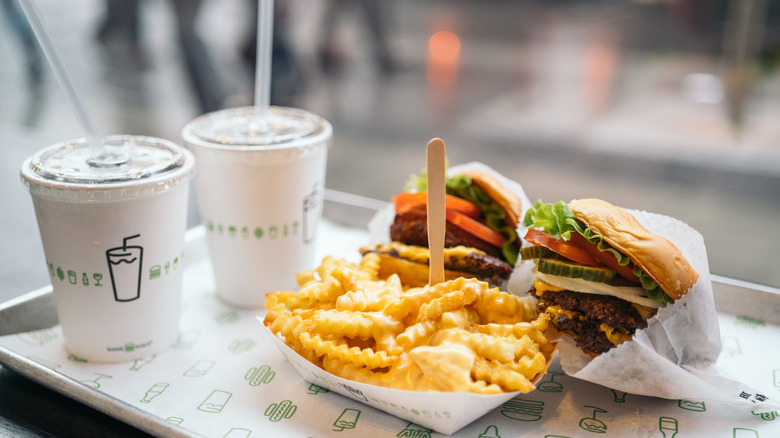The Scientific Reason Why Dipping Fries In Milkshakes Is Such A Delicious Combo
Milkshakes, fries, and burgers are classic American food. Even the idea of a juicy hamburger, fresh-cut fries, and a tall, ice-cold milkshake brings to mind 1950s-era burger joints and packed fast-food restaurants. Many restaurants today continue to uphold this traditional American meal, such as Johnny Rocket's or Steak N' Shake.
Perhaps one of the more notable things about serving up milkshakes and French fries is how well this particular type of food and drink go together. Some people go so far as to actually dip their fries, still hot and covered in salt, into the milkshake just as they would with ketchup. On paper, this shouldn't sound like it works, let alone even be something good. But some people enjoy doing it and can attest to it being a delicious and popular choice. It's a habit that's so popular that some restaurants, like Wendy's, have even encouraged customers to dip their fries into their milkshakes (or, in Wendy's case, a Frosty).
But what exactly is it about French fries and milkshakes that makes them so good? How do two completely separate foods ordinarily never served together somehow work in one specific scenario? The answer may lie in how our taste buds can perceive different flavors.
Salt can actually enhance sugar on our taste buds
In what should come as no surprise to many of us, our taste buds — those little bumps on our tongue — allow us to taste different flavors. It's what allows us to taste the saltiness of French fries or the sugariness of a milkshake. But could it be possible that our taste buds can "enhance" certain flavors, even if they directly contradict each other?
According to a study headed by the Proceedings of the National Academy of Science in 2011, certain "sugar receptors" located on the taste buds that perceive and control sweetness, known as "SGLT1" are responsible for enhancing the taste of sweet and salty foods. These receptors are only activated in the presence of salty and sweet foods, such as a French fry dipped into milkshakes or ice cream, which in turn leads to the food in question tasting much better than it usually would. Rather than having your salty taste buds and your sweet taste buds try to cancel each other out, your tongue has this specialized set of receptors that can allow both flavors to be enhanced at the same time.
These SGLT1 receptors aren't just activated when you eat salty or sweet foods, like a soft-serve-covered French fry. This same principle applies to other foods, such as salted caramel or chocolate-covered pretzels. The sugariness is not only complimented by the bite of salt, but it's also enhanced by it.
French fries and milkshakes also have two different textures
Take a look at your average fast-food French fry. How would you describe it? At its prime, when it's fresh out of the fryer, you'd probably say that it's hot, crispy on the outside, and soft and fluffy on the inside. Now, look at your average fast-food milkshake. You would probably note that, unlike the French fry, it's cold, creamy, and thick while not being too solid. These contrasting textures, while seemingly incompatible, are also what helps to make the combination of French fries in milkshakes good.
As Shelly Thobe, director of culinary innovation at Wendy's, explains to Thrillist, it's this combination of differing textures— the cold soft-serve texture of the milkshake and the hot, crispy texture of the fries—that "excites" our taste buds. Our taste buds not only register heat and cold temperatures but also register saltiness, sweetness, crispiness, and softness all at once. It's like a moderate form of sensory overload, something that activates both your sense of taste but also your sense of touch.
Think of it like eating a piece of hot apple pie with a scoop of ice cream on it, or drinking a cup of hot chocolate with whipped cream on top. It's this fusion of two wildly different textures and temperatures at perfect balance, neither overpowering the other, that makes such a combination palatable. It's a form of experiencing the best of both worlds at once.


